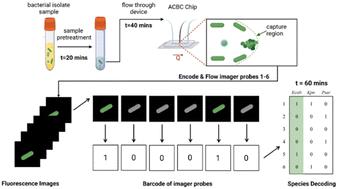Our official English website, www.x-mol.net, welcomes your
feedback! (Note: you will need to create a separate account there.)
Rapid identification of bacterial isolates using microfluidic adaptive channels and multiplexed fluorescence microscopy
Lab on a Chip ( IF 6.1 ) Pub Date : 2024-09-06 , DOI: 10.1039/d4lc00325j Stelios Chatzimichail 1, 2 , Piers Turner 1, 2 , Conor Feehily 3 , Alison Farrar 1, 2 , Derrick Crook 3, 4 , Monique Andersson 3, 4 , Sarah Oakley 3, 4 , Lucinda Barrett 3, 4 , Hafez El Sayyed 1, 2 , Jingwen Kyropoulos 1 , Christoffer Nellåker 5 , Nicole Stoesser 3, 4 , Achillefs N Kapanidis 1, 2
Lab on a Chip ( IF 6.1 ) Pub Date : 2024-09-06 , DOI: 10.1039/d4lc00325j Stelios Chatzimichail 1, 2 , Piers Turner 1, 2 , Conor Feehily 3 , Alison Farrar 1, 2 , Derrick Crook 3, 4 , Monique Andersson 3, 4 , Sarah Oakley 3, 4 , Lucinda Barrett 3, 4 , Hafez El Sayyed 1, 2 , Jingwen Kyropoulos 1 , Christoffer Nellåker 5 , Nicole Stoesser 3, 4 , Achillefs N Kapanidis 1, 2
Affiliation

|
We demonstrate the rapid capture, enrichment, and identification of bacterial pathogens using Adaptive Channel Bacterial Capture (ACBC) devices. Using controlled tuning of device backpressure in polydimethylsiloxane (PDMS) devices, we enable the controlled formation of capture regions capable of trapping bacteria from low cell density samples with near 100% capture efficiency. The technical demands to prepare such devices are much lower compared to conventional methods for bacterial trapping and can be achieved with simple benchtop fabrication methods. We demonstrate the capture and identification of seven species of bacteria with bacterial concentrations lower than 1000 cells per mL, including common Gram-negative and Gram-positive pathogens such as Escherichia coli and Staphylococcus aureus. We further demonstrate that species identification of the trapped bacteria can be undertaken in the order of one-hour using multiplexed 16S rRNA-FISH with identification accuracies of 70–98% with unsupervised classification methods across 7 species of bacteria. Finally, by using the bacterial capture capabilities of the ACBC chip with an ultra-rapid antimicrobial susceptibility testing method employing fluorescence imaging and convolutional neural network (CNN) classification, we demonstrate that we can use the ACBC chip as an imaging flow cytometer that can predict the antibiotic susceptibility of E. coli cells after identification.
中文翻译:

使用微流体自适应通道和多重荧光显微镜快速鉴定细菌分离物
我们展示了使用自适应通道细菌捕获 (ACBC) 设备快速捕获、富集和鉴定细菌病原体。通过在聚二甲基硅氧烷 (PDMS) 器件中对器件背压进行受控调整,我们能够受控地形成捕获区域,能够以接近 100% 的捕获效率从低细胞密度样品中捕获细菌。与传统的细菌捕获方法相比,制备此类设备的技术要求要低得多,并且可以通过简单的台式制造方法实现。我们展示了捕获和鉴定细菌浓度低于 1000 个细胞/mL 的 7 种细菌,包括常见的革兰氏阴性和革兰氏阳性病原体,如大肠杆菌和金黄色葡萄球菌。我们进一步证明,使用多重 16S rRNA-FISH 可以在一小时内对捕获细菌进行物种鉴定,使用 7 种细菌的无监督分类方法,鉴定精度为 70-98%。最后,通过使用 ACBC 芯片的细菌捕获能力,采用采用荧光成像和卷积神经网络 (CNN) 分类的超快速药敏试验方法,我们证明了我们可以将 ACBC 芯片用作成像流式细胞仪,可以预测鉴定后大肠杆菌细胞的抗生素敏感性。
更新日期:2024-09-06
中文翻译:

使用微流体自适应通道和多重荧光显微镜快速鉴定细菌分离物
我们展示了使用自适应通道细菌捕获 (ACBC) 设备快速捕获、富集和鉴定细菌病原体。通过在聚二甲基硅氧烷 (PDMS) 器件中对器件背压进行受控调整,我们能够受控地形成捕获区域,能够以接近 100% 的捕获效率从低细胞密度样品中捕获细菌。与传统的细菌捕获方法相比,制备此类设备的技术要求要低得多,并且可以通过简单的台式制造方法实现。我们展示了捕获和鉴定细菌浓度低于 1000 个细胞/mL 的 7 种细菌,包括常见的革兰氏阴性和革兰氏阳性病原体,如大肠杆菌和金黄色葡萄球菌。我们进一步证明,使用多重 16S rRNA-FISH 可以在一小时内对捕获细菌进行物种鉴定,使用 7 种细菌的无监督分类方法,鉴定精度为 70-98%。最后,通过使用 ACBC 芯片的细菌捕获能力,采用采用荧光成像和卷积神经网络 (CNN) 分类的超快速药敏试验方法,我们证明了我们可以将 ACBC 芯片用作成像流式细胞仪,可以预测鉴定后大肠杆菌细胞的抗生素敏感性。


















































 京公网安备 11010802027423号
京公网安备 11010802027423号